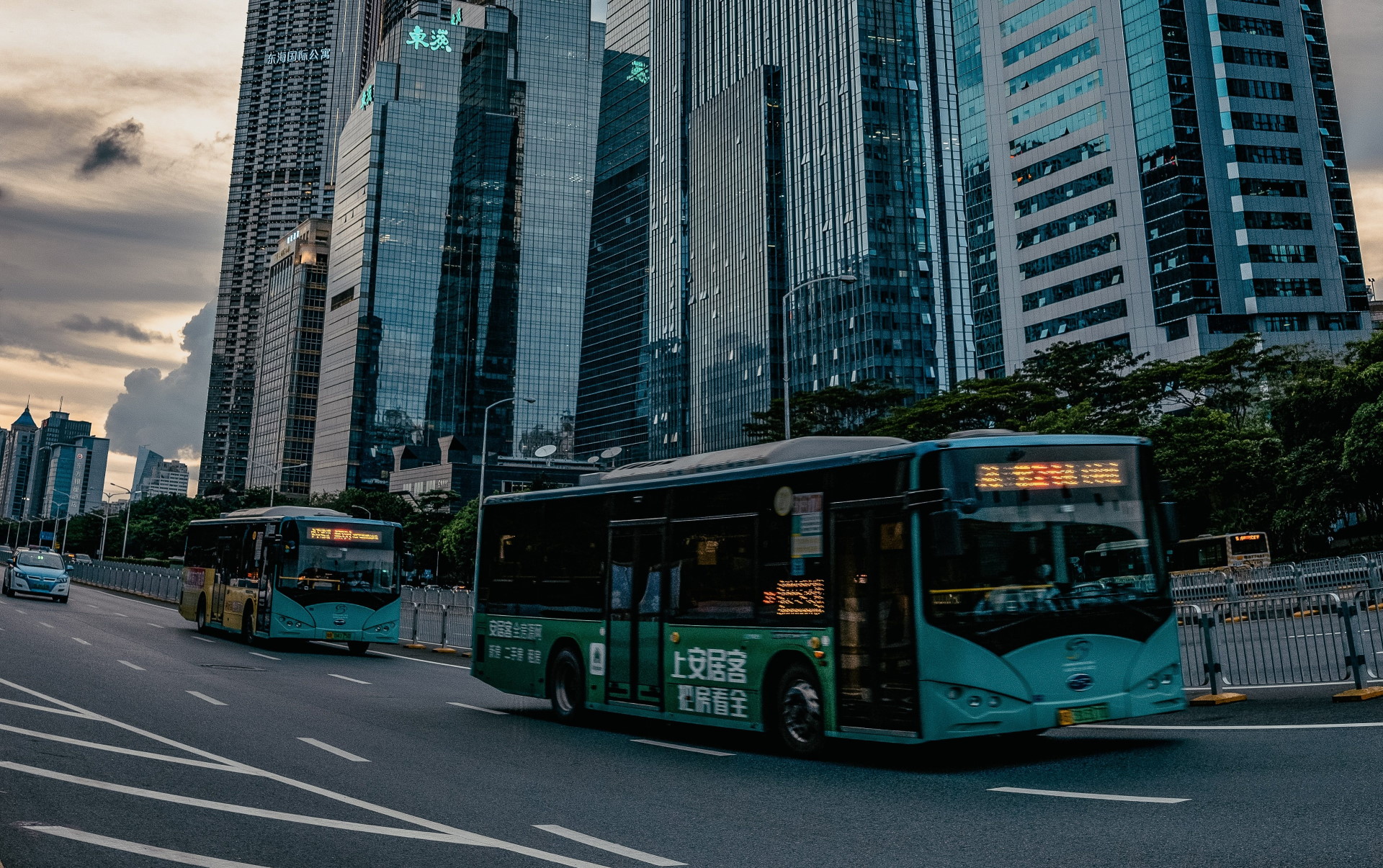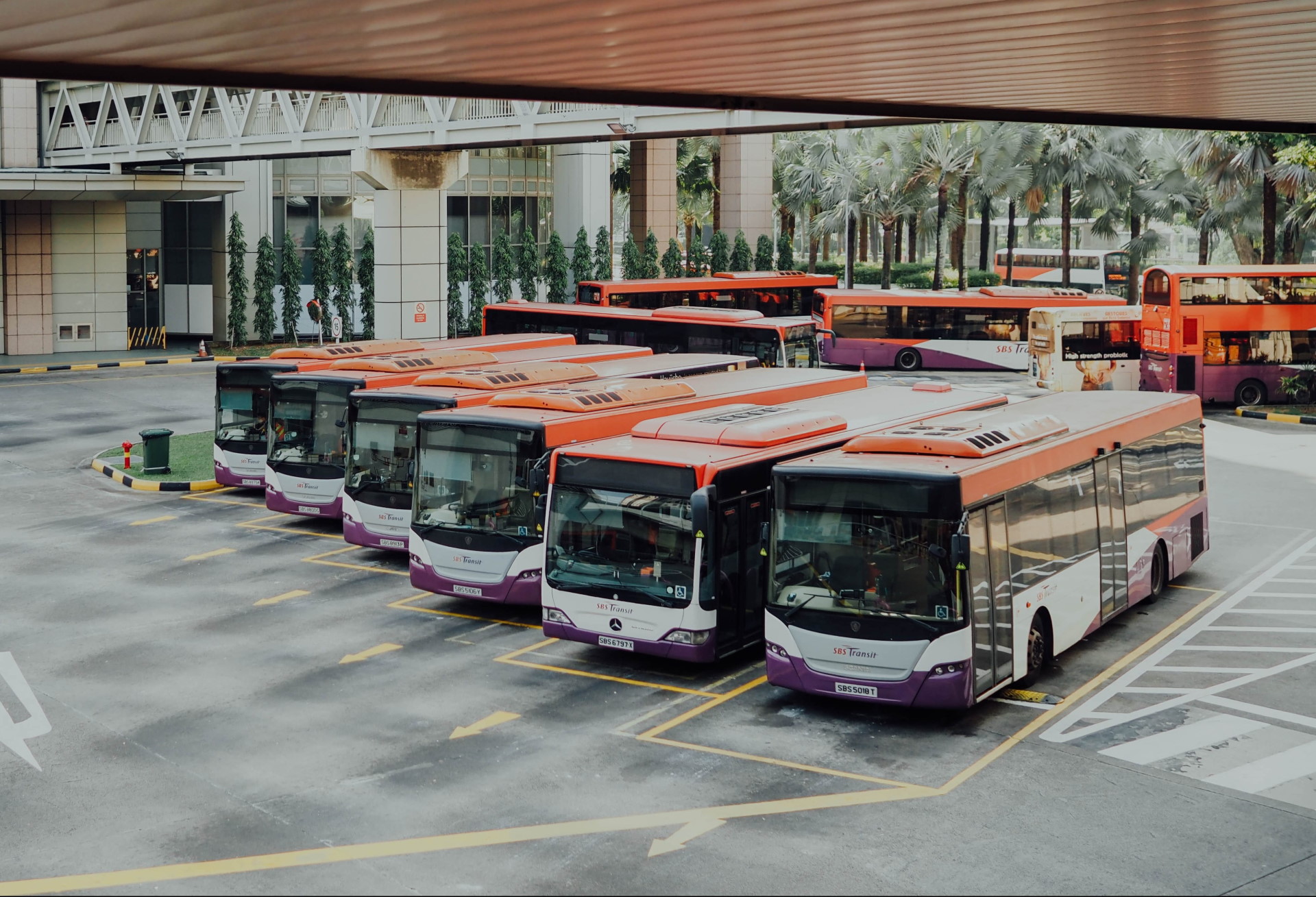Across the globe, municipalities took the initiatives of shaping a greener urban future by quickly advancing and accelerating the bus fleet electrification process. Some cities have recognized the benefits of adopting electric buses in the very early stage of development. We are going to take a look at one city that leads the way in the bus fleet electrification field and explore how it accomplished this complex task.
Looking for more information about why fleets are looking at adopting greener technologies? Read the first part of this article here.
An 16,000 Electric Bus Fleet In Shenzhen, China
Shenzhen, a modern metropolitan city located in southern China, owns the world’s first and largest all-electric bus fleet. All 16,000 city’s public transit buses and 22,000 taxis are operating 100% on electric power. This fast-growing city is also the home to the largest electric vehicle manufacturer, BYD.
The Shenzhen Bus Group, the major bus transit agency in Shenzhen, estimated that by converting the entire fleet to electric, they are able to conserve 160,000 tonnes of coal per year and reduce annual CO₂ emissions by 440,000 tonnes. However, it’s important to note that Shenzhen didn’t have any electric buses let alone an electric bus fleet prior to 2010.
So how did a city grow from zero to 16,000 electric buses in just under a decade? There are many reasons and factors that contributed to this green accomplishment.
Growing Environmental And Health Concerns
Stepping into the 21st Century, China faces growing public concerns and criticisms about the deteriorating urban environment and air quality due to a spike in the concentration of lung-damaging particles called PM2.5. This increase is primarily attributed to the industry’s heavy expansion, increased private vehicles on the roads, and a profit-focused economic development national strategy.
Heavy pollution often leads to smog, an unfavourable intense air pollution condition that could have detrimental effects on human and ecosystem health. The situation worsened year after year, forcing the government to take action and introduce policies to reduce urban carbon emissions.
Converting the entire country’s bus fleet into an all-electric fleet is an important first step in mitigating carbon impacts and restore the environment on the government’s agenda.
Shenzhen has been selected as a pilot city to experiment with the fleet electrification project, primarily due to Shenzhen being a quite innovative city in China and the upcoming 2021 Universiade games. The city has been onboard with this ambitious plan of replacing all city’s 16,000 buses with electric buses, and hopefully, pave the way and serve as an example for other cities in China.
Governmental Support Of Transitioning To Electric Fleet
One of the key factors for any transit agency to transition into an electric fleet is getting wide support and funding from the local government. Electric bus units are often more expensive than the conventional buses in terms of purchase prices and upfront costs. However, as battery prices are rapidly dropping due to technological innovations and lowering manufacturing costs, it is highly likely that we will see more affordable electric bus models launched into the market in the near future.
Investing In The Right Infrastructures
Investing and establishing electric bus infrastructures is an essential practice in supporting and accelerating the adoption of electric buses. Knowing how to strategically place charging stations across the city directly impacts the electric bus network’s operational efficiency.
Shenzhen took a pioneering approach by installing charging stations at bus depots for overnight charging and also built charging stations at bus terminus so vehicles can charge periodically when they layovers. This ensures buses have enough battery energy to cover the entire day operations without the need to be taken out of service in the middle of the day for a lengthy full charge. It also maximizes vehicles’ utilization rates to make sure they spend more time on roads serving customers rather than being parked at charging stations, waiting for a charge. Additionally, the city opens these charging stations to other city-service vehicles, such as taxis, to improve charging infrastructures’ utilization rates. The results are astonishing, as these infrastructures accelerate the transitions of all 22,000 city taxis to a fully electric fleet.
Enhanced Manufacturer’s Support
A primary key concern raised by many transit agencies is whether the electric bus can have the same life expectancy as the conventional bus. The degree of battery degradation has a direct impact on the vehicle’s operational range and overall system productivity. Though most of the current electric bus manufacturers promised a vehicle lifecycle of 8 to 10 years or 100,000 miles, similar to what a conventional diesel bus can deliver, hesitation and indecision still exist among transit agencies over the reliability of electric buses.
Shenzhen Bus Group was confronted with the uncertainty associated with the bus battery performance at the early stage of the transition process. However, this uncertainty was solved by negotiating with vehicle manufacturers for a lifetime warranty of the vehicles’ battery. It’s important to note that one of the main reasons why the vehicle manufacturer was willing to offer a lifetime warranty is because they were able to manage the financial risks through continuously innovating battery technologies. Having strong foundational technological support from the manufacturers is an essential pillar to ensure the fleet electrification process can succeed and sustain in the long term.
The success of the bus electrification project in Shenzhen, China, highlighted that the bus electrification process relies on the support from multiple key stakeholders, strategic infrastructure, asset allocation and management.
Now, the following question remains: how can data be collected to not only track progress towards a greener future, but to ensure typical fleet management occurs?
The Role of Telematics in Electric Fleets
Electric Vehicle Suitability Assessment: Bringing You The World’s Largest Electric Vehicle Real-World Range Dataset
Electric vehicle adoption cannot succeed without telematics. From the preparation and consultation at the beginning of the process to the fleet scale management in the later stage of adoption, telematics plays a critical role in every part of the journey.
The EVSA (Electric Vehicle Suitability Assessment) is a systematic data-driven process that informs fleet managers about which parts of the fleet are suitable to transition to electric. Through leveraging the world’s largest electric vehicle real-world range dataset and analyzing the current fleet’s unique driving profile and historical patterns, the system can make personalized recommendations of fleet electrification blueprint and best implementation practices.
For transit agencies, not all buses in the depot are suitable or cost-beneficial to be converted to the electric bus immediately. Buses in newer conditions or those that were recently bought by transit agencies certainly should not be phased out before reaching the end of their lifecycle.
Range and the availability of charging infrastructures are some key considerations for transit agencies when it comes to fleet planning and deployment. They are more likely to pilot and deploy electric buses on shorter bus routes or routes with sufficient charging infrastructures. The EVSA has the best ability to know which route is fitted for electric bus operations after analyzing thousands of similar real-world scenarios, giving fleet managers the full confidence to implement plans.
Costs of fleet electrification are always a major concern for any business, including transit agencies. The EVSA will provide fleet managers with a clear comparison between the costs of operating the existing fleet and the costs of operating an electric vehicle fleet. Fleet managers could determine which approach or strategy they should be undertaking that best suits their budget. They are also able to view the initial expense and long-term savings of adoption to the electric vehicle fleet, paving the way for presenting these data to city council for approval.
Largest Set of Supported Electric Vehicle Models
The electric bus market is rapidly expanding as new vehicle models are introduced into the market every month. To provide the best possible support of the entire fleet operation, fleet managers need a telematics solution that supports all types of electric vehicle models in the fleet. That means telematic solutions must keep up with the growth of electric vehicle markets by continually adding vehicle support every month.
A winning solution should evolve with the changing market and support a broad range of electric bus models, so transit agencies can purchase any model they want without any constraints.
Highly Customizable Software Platform
Similar to other industries, transit agencies desire a high degree of customization on the telematics platform to add features to cater to their needs. The telematics solution providers have to offer customers a wide selection of add-on features and software integration capability so that transit agencies can migrate their existing features such as automatic passengers counting solutions, crowd monitoring systems, and a variety of transit-oriented software systems to the new electric fleet management platform. Telematics offers new exciting features such as battery degradation monitoring, energy use tracking, and temperature impacts on range real-time analytics tools to provide comprehensive electric fleet support.
Electric Vehicle Charge Assurance Dashboard: Guarantee A Smooth Operation
Service reliability is a vital metric for transit operations. No transit agency wants to see one of their vehicles break down or declare out of service in the middle of passenger route due to low battery. The Electric Vehicle Charge Assurance Dashboard is a useful tool that enables fleet managers to monitor vehicle charging status in real-time. Fleet managers will get an alert if the vehicle wasn’t plugged in or charging didn’t start correctly. The dashboard also warns fleet managers of any electric vehicle that didn’t reach the specified battery level due to a charging issue, allowing fleet managers to take preventive actions such as taking the vehicle out of service early.
The Future Of Electric Buses
As battery technologies continue to improve and evolve, we expect to see buses with improved range and longer lifecycles in the future. The extended range will open up new opportunities and provide more flexibility to transit agencies in terms of route planning and work assignment.
Expanding charging infrastructures and developing new charging technologies can also significantly improve operational flexibility and vehicle utilization rates. Wireless charging provides a glimpse into the visionary future of electric bus charging solutions. The wireless solution involves charging pads positioned at terminus and bus layover points. Whenever the bus stops on the charging pad for a brief layover, the bus automatically adds energy to its battery through an air gap. This flexible “on-route” charging solution allows buses to complete unlimited cycles of trips without the need to return to the depot for a lengthy full charge. It is a transformative technology that allows electric buses to operate routes of any length without range concerns.
There is no doubt that the electric bus is the future of public transit. It is our answer and response to the worsening global environment, declining community health, and increasing social burdens. Transitioning to renewable energy is the mission of our generation. The electric bus is just the beginning of this challenging journey.
Contact us to speak with a fleet electrification expert to see how we can leverage telematics technologies to help your fleets go electric.

